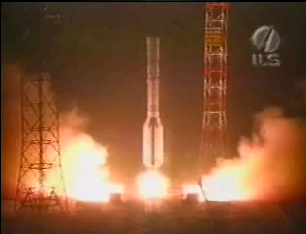Proton Rocket Successfully Launches U.S. Satellite

Satellite television fans have new asset in the sky tonight after the successful launch of an American communications satellite from Baikonur Cosmodrome in Kazakhstan.
Sitting atop a Russian-built Proton rocket, the AMC-15 satellite launched into space on a mission to provide video and broadband services to television-goers across the entire United States.
"We're thrilled to be part of this event," said Bryan McGuirk, senior vice president of SES AMERICOM, from Baikonur before launch. "All is set to go."
Built by Lockheed Martin for the Princeton, New Jersey-based satellite provide SES AMERICOM, AMC-15 left Earth at 5:23 p.m. EDT (2123 GMT), though it was a still-dark morning at the flight's Baikonur staging ground at Launch Pad 39.
The flight was marketed by McLean, Virginia's International Launch Services, and went off without a hitch despite periodic sandstorms earlier in the day, which proved a problem for ground operations, launch officials said.
"AMC-15 is an important satellite for SES AMERICOM, expanding the resources available for direct-to-home video and broadcast applications," said ILS chief Mark Albrecht before the launch.
After separating from its Proton booster 9 minutes 48 seconds after launch, AMC-15 ignited its Breeze M upper stage for the first of three engine burns to place the satellite into a transfer orbit. Spacecraft separation is expected to take place early Friday at 12:18 a.m. EDT (0418 GMT), with AMC-15 using its own engine to slide into a geostationary orbit 22,300 miles (36,000 kilometers) above Earth at 105 degrees longitude.
Breaking space news, the latest updates on rocket launches, skywatching events and more!
With 12 Ka-band spot beams and 24 Ku-band transponders, AMC-15 is the first satellite dedicated to SES AMERICOM's AMERICOM2Home program. After conducting a series of tests, the satellite provider will ready the spacecraft for use by EchoStar's DISH Network to provide home entertainment services.
"AMC-15 is pivotal to our strategic and expanding relationship with EchoStar," said Dean Olmstead, SES AMERICOM president and CEO, in a statement about the mission. "AMERICOM is ready to operate its first Ka-band payload, and we believe EchoStar will fully utilize the satellite's spectrum to expand their offerings to their subscribers."
AMC-15's launch is 2004's ninth ILS mission - the fourth using the Proton launch vehicle - and the third of five flights the company is marketing for SES AMERICOM. The spacecraft's twin, AMC-16, is set for launch later this year.

Tariq is the award-winning Editor-in-Chief of Space.com and joined the team in 2001. He covers human spaceflight, as well as skywatching and entertainment. He became Space.com's Editor-in-Chief in 2019. Before joining Space.com, Tariq was a staff reporter for The Los Angeles Times covering education and city beats in La Habra, Fullerton and Huntington Beach. He's a recipient of the 2022 Harry Kolcum Award for excellence in space reporting and the 2025 Space Pioneer Award from the National Space Society. He is an Eagle Scout and Space Camp alum with journalism degrees from the USC and NYU. You can find Tariq at Space.com and as the co-host to the This Week In Space podcast on the TWiT network. To see his latest project, you can follow Tariq on Twitter @tariqjmalik.
